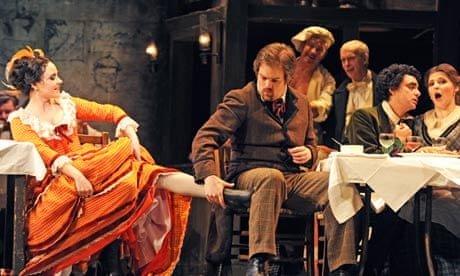The poor, cold students in Puccini's La bohème, reduced to picturesque desperation in their Parisian garret, long for the coming of spring. Mimi the seamstress instead wishes winter would never end. She knows consumption will have finished her long before the leaves are on the trees. Since you can probably catch La bohème somewhere around the world any time of the year, it is perverse to think of it as a seasonal opera. Yet its opening scenes in the Latin Quarter on Christmas Eve, with the extravagant festivities at Cafe Momus and the magical if grim post-New Year snow music of Act III, make this the ideal opera for the last, dark weeks of the year.
That, anyway, was one reason for returning to John Copley's much loved 1974 production at the Royal Opera House, rather needlessly described in the press notes as "naturalistic". We can assume that any opera featuring a real dog falls into that category, and the comfortable looking sickbed appeared only too inviting to those of us coughing and spluttering along with Mimi in the last act. Indeed the Latvian soprano Maija Kovalevska sounded lusty and fit right to the end, which might not have been Puccini's intention given she's about to die. Kovalevska's voice is secure and accurate but just a degree of frailty would have worked wonders for that promised naturalism.
Another excuse was the presence of Rolando Villazón, the watchable and likable Mexican tenor, in the leading role of Rodolfo. As it turned out, this was a so-so Bohème, not quite gelling on Monday night and spanning a jerky mix from grand emotion to Grand Guignol. Villazón, small and febrile with his shock of curls and huge brown eyes, holds the stage like a silent movie star – think Buster Keaton – and his humour, as well as his final grief, do much to compensate for an underpowered voice and some dodged top notes. This had the makings of a lateral reading of one of the world's most popular operas, with Rodolfo and Musetta (the expressive Ukrainian-American soprano Stefania Dovhan) sounding more alert to physical vulnerability than Mimi herself.
Yet both Dovhan and Villazón captured some of the work's vitality, helped by the Norwegian baritone Audun Iversen's sturdy Marcello and Donald Maxwell's deliciously encrusted cameo as Musetta's lampooned sugar daddy Alcindoro. The Royal Opera's 50-strong Youth Opera Company – children aged nine to 13 from "a wide variety of backgrounds" – gave well-drilled energy to the astonishing Cafe Momus scene, chasing after the toy-seller Parpignol while the parallel sagas of two pairs of lovers, not to mention the goings on of soldiers, street vendors and waiters, unfold. Copley handles this with skill, always placing soloists in a part of stage, in Julia Trevelyan Oman's detailed sets, where their voices have the best chance of sounding their best (not always the case with empty, minimalist stagings whether you like the aesthetic or not).
Under the baton of Mark Elder there was some bumpiness in the pacing, with lavish caressing of climactic moments but occasional falters elsewhere. The orchestra had great moments – the jaunty oboe in the opening ensemble, the upward swirling clarinet in O soave fanciulla, the solo strings as Mimi lay dying – and by the time it reaches cinemas worldwide on Tuesday 15 January, all should be well.
Two other year-end performances resulted in standing ovations as well as one broken resolution. Philip Glass, as part of the Barbican's celebration of his 75th birthday, was at the keyboard alongside members of the Britten Sinfonia, his own Philip Glass Ensemble and the Trinity Laban Chamber Choir for a live-music relay, with revised scoring, of the cult film Koyaanisqatsi. First seen in 1982, Godfrey Reggio's powerful cinematic vision showing man's journey towards self-destruction – from desert to mushroom-cloud devastation – remains a sober and prophetic achievement. That Glass was there, pounding out his broken chords and pulsating rhythms, heightened the mood of poignant concentration.
Having vowed to banish all Wagner until the anniversary year begins in January, I had overlooked the imperative of Bryn Terfel in the title role of Der fliegende Holländer in a Zurich Opera concert performance at the Southbank, stolidly conducted by Alain Altinoglu. With the exception of Anja Kampe's coruscating Senta and Matti Salminen's salty but brilliant Daland, all attention fell on Terfel: he unfurled restless vocal energy to achieve almost incredible fortissimos, while equally hushed when Wagner demands. This was an extraordinary performance. I'll endeavour to make more manageable resolutions for 2013.

Comments (…)
Sign in or create your Guardian account to join the discussion